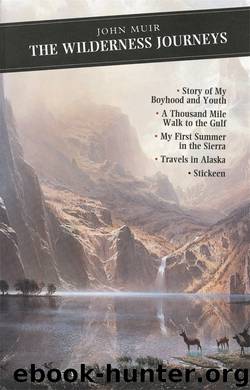The Wilderness Journeys by John Muir

Author:John Muir [John Muir]
Language: eng
Format: epub
ISBN: 9781847675705
Publisher: Canongate Books
Published: 2009-03-21T16:00:00+00:00
SIX
Mount Hoffman and Lake Tenaya
July 26. Ramble to the summit of Mount Hoffman, eleven thousand feet high, the highest point in life’s journey my feet have yet touched. And what glorious landscapes are about me, new plants, new animals, new crystals, and multitudes of new mountains far higher than Hoffman, towering in glorious array along the axis of the range, serene, majestic, snow-laden, sun-drenched, vast domes and ridges shining below them, forests, lakes, and meadows in the hollows, the pure blue bell-flower sky brooding them all, – a glory day of admission into a new realm of wonders as if Nature had wooingly whispered, ‘Come higher.’ What questions I asked, and how little I know of all the vast show, and how eagerly, tremulously hopeful of some day knowing more, learning the meaning of these divine symbols crowded together on this wondrous page.
Mount Hoffman is the highest part of a ridge or spur about fourteen miles from the axis of the main range, perhaps a remnant brought into relief and isolated by unequal denudation. The southern slopes shed their waters into Yosemite Valley by Tenaya and Dome Creeks, the northern in part into the Tuolumne River, but mostly into the Merced by Yosemite Creek. The rock is mostly granite, with some small piles and crests rising here and there in picturesque pillared and castellated remnants of red metamorphic slates. Both the granite and slates are divided by joints, making them separable into blocks like the stones of artificial masonry, suggesting the Scripture ‘He hath builded the mountains.’ Great banks of snow and ice are piled in hollows on the cool precipitous north side forming the highest perennial sources of Yosemite Creek. The southern slopes are much more gradual and accessible. Narrow slot-like gorges extend across the summit at right angles, which look like lanes, formed evidently by the erosion of less resisting beds. They are usually called ‘devil’s slides,’ though they lie far above the region usually haunted by the devil; for though we read that he once climbed an exceeding high mountain, he cannot be much of a mountaineer, for his tracks are seldom seen above the timber line.
The broad grey summit is barren and desolate-looking in general views, wasted by ages of gnawing storms; but looking at the surface in detail, one finds it covered by thousands and millions of charming plants with leaves and flowers so small they form no mass of colour visible at a distance of a few hundred yards. Beds of azure daisies smile confidingly in moist hollows, and along the banks of small rills, with several species of eriogonum, silky-leaved ivesia, pentstemon, orthocarpus, and patches of Primula suffruticosa, a beautiful shrubby species. Here also I found bryanthus, a charming heathwort covered with purple flowers and dark green foliage like heather, and three trees new to me – a hemlock and two pines. The hemlock (Tsuga Mertensiana) is the most beautiful conifer I have ever seen; the branches and also the main axis
Download
This site does not store any files on its server. We only index and link to content provided by other sites. Please contact the content providers to delete copyright contents if any and email us, we'll remove relevant links or contents immediately.
Hit Refresh by Satya Nadella(8343)
When Breath Becomes Air by Paul Kalanithi(7268)
The Girl Without a Voice by Casey Watson(7267)
Do No Harm Stories of Life, Death and Brain Surgery by Henry Marsh(6340)
A Court of Wings and Ruin by Sarah J. Maas(6100)
Hunger by Roxane Gay(4228)
Shoe Dog by Phil Knight(4176)
Everything Happens for a Reason by Kate Bowler(4074)
A Higher Loyalty: Truth, Lies, and Leadership by James Comey(4038)
The Rules Do Not Apply by Ariel Levy(3910)
Tuesdays with Morrie by Mitch Albom(3836)
The Immortal Life of Henrietta Lacks by Rebecca Skloot(3830)
How to Change Your Mind by Michael Pollan(3681)
Millionaire: The Philanderer, Gambler, and Duelist Who Invented Modern Finance by Janet Gleeson(3573)
All Creatures Great and Small by James Herriot(3521)
Elon Musk by Ashlee Vance(3457)
Tokyo Vice: An American Reporter on the Police Beat in Japan by Jake Adelstein(3441)
Man and His Symbols by Carl Gustav Jung(3322)
The Money Culture by Michael Lewis(3290)
